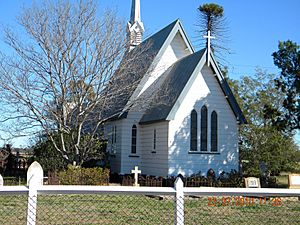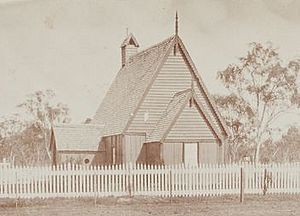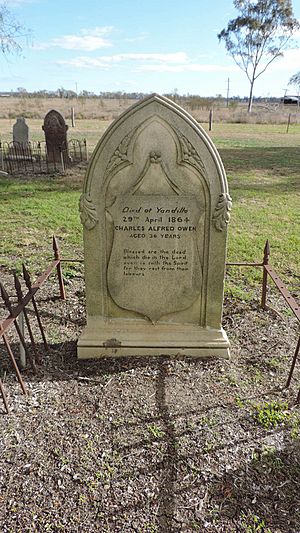All Saints Anglican Church, Yandilla facts for kids
Quick facts for kids All Saints Anglican Church, Yandilla |
|
|---|---|

All Saints Anglican Church, 2010
|
|
| Location | Gore Highway, Yandilla, Toowoomba Region, Queensland, Australia |
| Built | 1878 |
| Official name: All Saints Anglican Church and cemetery Yandilla, All Saints Church of England | |
| Type | state heritage (built, landscape) |
| Designated | 21 October 1992 |
| Reference no. | 600722 |
| Significant period | 1860s–1880s (historical) 1860s–1920s (fabric) ongoing (social) |
| Significant components | stained glass window/s, grave surrounds/railings, tower – bell / belfry, memorial/monument, fencing, headstone, graveyard, spire, church, cemetery, pipe organ, furniture/fittings |
| Builders | John Baillie |
| Lua error in Module:Location_map at line 420: attempt to index field 'wikibase' (a nil value). | |
All Saints Anglican Church and its cemetery in Yandilla is a special old church in Queensland, Australia. It's located on the Gore Highway near Toowoomba. This beautiful timber church was built around 1878 by a local carpenter named John Baillie. It's also known as All Saints Church of England. Because of its history and importance, it was added to the Queensland Heritage Register on October 21, 1992.
Contents
The Church's Story
Early Days at Yandilla
The All Saints Church you see today is made of timber. It was built around 1878 by the Gore family at Yandilla Station. It stands on the same spot as an older church and looks very similar to it. The graveyard around the church started in 1863. Before that, people were usually buried closer to the main house.
The Gore family were landowners from Ireland. They moved to Australia for health reasons. In 1841, brothers Ralph and St George Gore came to the Darling Downs with sheep. They started a large farm called Yandilla. Their other brothers, Robert and St John, soon joined them. St George later became an important politician in Queensland.
A Community Hub
The Gore family were very religious Anglicans. They felt responsible for the people working on their farm. Many people lived at Yandilla Station, not just the Gore family. The station was like a small village. It had homes for workers, a store, and places for trades like blacksmiths. In 1843, a visitor reported that 30 people lived there. There was also a woolshed and 11 huts.
In those early days, ministers rarely visited. The first church service at Yandilla was likely in 1843. Reverend Benjamin Glennie, a hardworking pioneer minister, first visited Yandilla in 1848. From 1850, he visited regularly. The ladies of Yandilla also ran a Sunday School for the children. It's thought there was a small chapel from the very beginning, perhaps part of the main house.
Building the First Church
Reverend William Gore, another member of the Gore family, often visited Yandilla. He held church services during his visits. In 1860, he became a major owner of the family farm. By then, the "village" at the station had over 100 people. A new church was built near the main house in 1863.
This first church was made of sawn timber. It was about 30 feet long and 20 feet wide. It had a small chancel (the area around the altar) and a porch (an entrance area). The roof was steeply pitched and looked very nice. A beautiful stained glass window was being made for the eastern end of the building. Even though a minister was appointed for the area in 1861, Reverend Gore often held services. This church was used by workers of all Christian faiths. Catholic services started there in 1862, and Presbyterian services began in 1891.
The Current Church
The church you see today was built in 1878. This was when Francis Gore, William Gore's oldest son, managed the property. Francis was very involved in local community matters. During this time, parts of large farms were sold off, which brought more people to the area. Some of these new settlers had worked on the station before.
The new church was built on the same spot as the old one. It looks very similar, so it might even use some materials from the first church. A local carpenter and store owner named John Baillie built it. He also built the courthouse and St Augustine's church in Leyburn. People say that station workers and Aboriginal people living at Yandilla helped Baillie build the church.
Reverend Gore passed away in 1885. On November 15, 1887, the church and graveyard were officially made sacred. This happened at the request of Francis, Gerard, and Robert Gore. On that day, Madame Blumenthal, who was once Leonie Gore and a major owner of Yandilla, gave three stained glass windows to the church. These windows were made in England and cost a lot of money. They were given in memory of her uncle, Reverend William Gore. They were placed in the chancel of the church. Even with this, Catholic services continued to be held at All Saints, and Madame Blumenthal helped pay for them.
Special Features and Changes
The church served more than just the people living at Yandilla. During shearing season, many shearers and seasonal workers came to services. In 1888, a special Christmas service was held for them. That same year, a pipe organ made by Reverend Gore was installed. It was built from oak wood from a tree in England. Around this time, two beautifully carved oak chairs and reading desks were also added. One was thought to be made in Italy, and the other was a copy made by John Baillie in 1886.
In 1890, a professional gardener named Hartley Moore was hired from London. He took care of the homestead gardens and also acted as a church caretaker. He planted shrubs and kept the church grounds looking nice.
Even though fewer people attended church over the years, a new spire (the tall, pointed top) and belfry (bell tower) were built in 1900. A bell was also brought from America. In the early 1900s, plans were made to divide and sell Yandilla. In 1906, it was sold to the Lomax Pastoral Company. In 1910, a new vestry (a room for the minister) was added to the church. In 1913, a stone font (a basin for baptisms) was placed in the church. It was in memory of Gerard Gore, who had passed away the year before. He had been a churchwarden for many years and continued to support the church financially.
Later Years
The number of people attending church continued to decrease. In 1919, a fire destroyed the Yandilla station office. This fire also destroyed many records about the church and cemetery. In 1923, the church saw a bit of a comeback. Reverend T Bird became the minister for Millmerran and Yandilla. John (Jack) Rademy became the manager of Yandilla for the new owners. Rademy and his wife were very active in church matters. They continued to support the church even after buying another property nearby. In 1924, the parish of Millmerran was formed. Services were held at Millmerran, Yandilla, and Leyburn. In 1925, new brass items and hangings were put in the church. In 1936, the Cowlishaw family took over Yandilla. They also took an interest in the church, keeping its connection to the property strong.
Other work done later includes an altar given in 1957 by Mrs. Hazel Fysh. In 1958, fourteen of the oldest gravestones were cleaned and repaired. Around 1968, the main road (now the Gore Highway) was moved to pass closer to the church. Any remaining trees that connected the church to the main house were likely removed then. None of the original homestead buildings are left today. The church was the oldest building in the area. The Gore family still cares about the church. Family reunions and christenings have been held there recently. In 1970, the Anglican Church received a new official document for the land with the church and graveyard. In 1975, All Saints was listed on the Register of the National Estate. In 1988, a stone monument was unveiled in memory of the Gore family.
What the Church Looks Like
All Saints Church is easy to spot in the flat landscape between Toowoomba and Millmerran. It's a timber building with a Gothic style. It sits on low stumps and has weatherboards on the outside. The roof is very steep and made of corrugated iron. At the western end, there's a belfry with louvers and a thin spire on top. The church is painted white on the outside, just as it was originally.
You enter the church through a porch on the south side. On the north side, there's a small vestry covered in vertical timber boards. Inside, the timber is oiled. Light comes in through plain lancet windows (tall, narrow windows with pointed tops). In the chancel, there are three lancet windows with beautiful stained glass. The chancel is connected to the eastern end of the church through a Gothic arch. It looks separate from the main part of the church because it's smaller. The stained glass windows are above the altar. They show Christ the King and are in memory of Reverend William Gore.
Two oak prayer desks and chairs are on either side of the chancel. They are heavily carved with figures like cherubs and lions. The rest of the church is simply furnished.
The Cemetery
There are 95 burials around the church. They date from 1864 to 1982. The earliest burial is Charles Owen, who was a manager and partner at Yandilla. He passed away in 1864. Some graves have railings. The most detailed grave, with fancy ironwork, belongs to Harriet Gore, who was Francis Gore's wife. There are some old trees in the grounds, including a bunya pine. A simple fence surrounds the churchyard.
Why It's Important
All Saints Anglican Church and cemetery Yandilla was added to the Queensland Heritage Register on October 21, 1992. This means it's a very important historical site.
- It shows how Queensland grew: The church helps us understand how early large farms, called pastoral runs, worked like small communities. Yandilla, started by the Gore family in 1841, had a "village" with a school and a church. The church, its memorials, and the graves of family members, workers, and early settlers are now the only visible signs of this old community.
- It's a great example of its kind: All Saints is a good and early example of a church with a graveyard right next to it. This was common in Europe but less so in Queensland.
- It's beautiful: The church building itself, along with the stained glass and furniture inside, is very beautiful.
- It's important to the community: The church has a long and special connection with the local community. The graveyard holds the burials of many pioneers who helped settle the area.
- It's linked to important people: The church, the family memorials inside, and the burials in the churchyard are strongly connected to the Gore family. They were very important in starting the farming industry in the Darling Downs and in the early political life of Queensland.
See also
- Anglican Diocese of Brisbane
- Anglo-Catholicism
- Liberal Anglo-Catholicism
- High church
- Ritualism in the Church of England
- Anti-Protestantism
- Progressive Christianity
- Liberal Christianity




